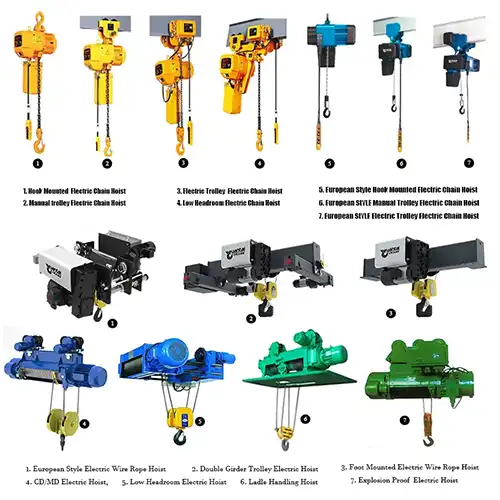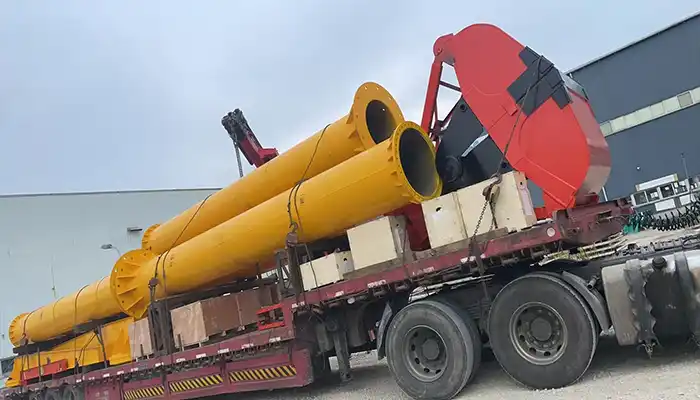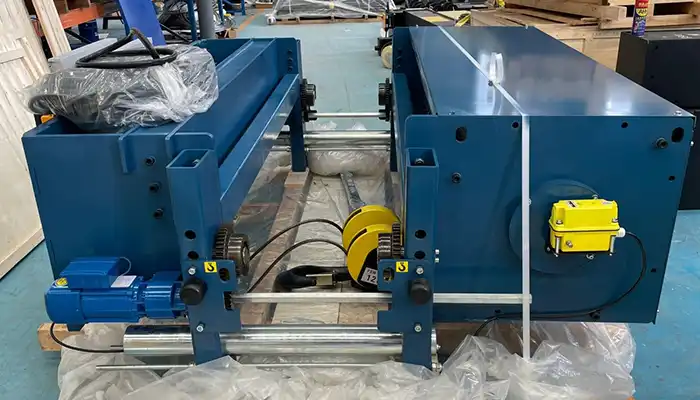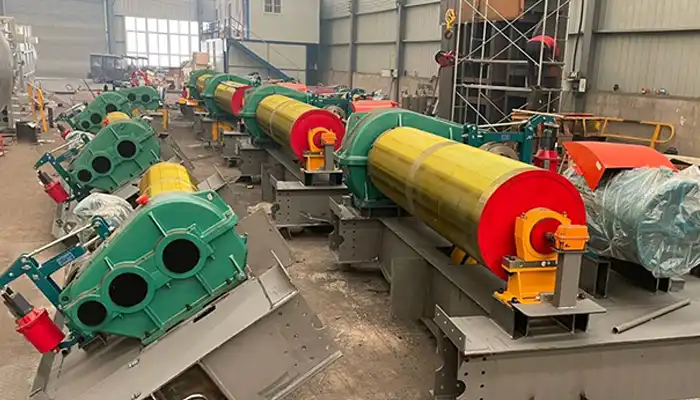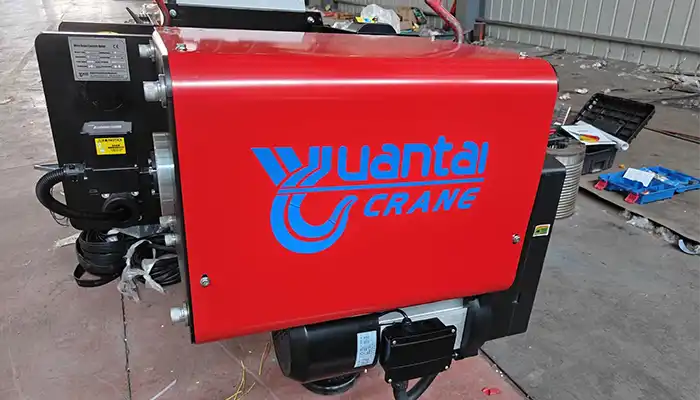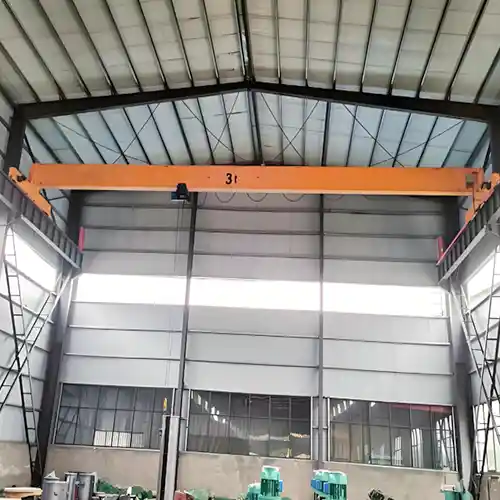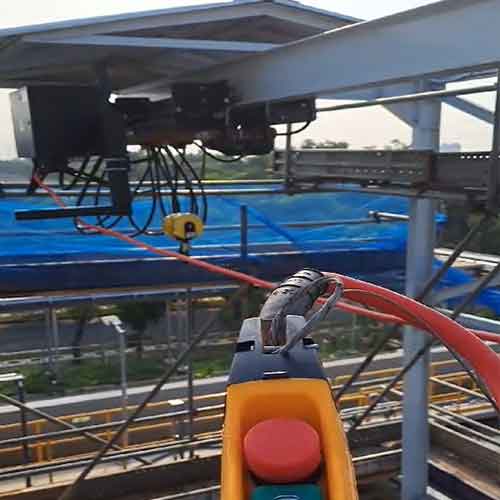3 Ton Electric Chain Hoist vs. 3 Ton Wire Rope Hoist
Compare 3-ton electric chain hoists &3 ton wire rope hoists to determine the best choice based on lifting needs. How to select the right electric hoist ?
Category: Featured
Your Trusted 3 Ton Electric Hoist Manufacturer & Supplier
3 Ton Electric Chain Hoist vs. 3 Ton Wire Rope Hoist
Which Type of Electric Hoist Is Best for Your Needs?
3 Ton Electric Chain Hoist & 3 Ton Wire Rope Hoist for Sale. Compare 3-ton electric chain hoists and wire rope hoists to determine the best choice based on lifting needs.
3 Ton Electric Hoists
Selecting the right electric hoist is more than just picking a lifting device. It affects work efficiency, safety, and long-term costs. Whether you're handling materials in a workshop, warehouse, or large-scale factory, choosing the best 3-ton hoist for your needs is essential.
When comparing lifting options, two of the most commonly used hoists are:
- 3-ton electric chain hoist – Uses a metal chain to lift loads. Compact, durable, and great for small to medium operations.
- 3-ton wire rope hoist – Uses a wire rope wound around a drum. Designed for faster, heavier, and high-frequency lifting.
At first glance, they seem similar because they both lift 3 tons. But their working mechanisms, durability, and ideal applications are quite different.
Why Does This Matter?
Choosing the wrong hoist can lead to:
- Higher costs due to frequent maintenance or replacements.
- Slower operations if the hoist isn't built for your workload.
- Safety risks if it can't handle your lifting environment.
So, which one is best for your needs?
In this article, we'll break down the differences, benefits, and ideal uses of each hoist. By the end, you'll have a clear answer to make the right purchase decision. Let's dive in!
Before choosing between a 3-ton electric chain hoist and a 3-ton wire rope hoist, it's important to understand how they work and where they are best used. While both are designed to lift 3 tons, they operate differently, have distinct advantages, and suit different working conditions. Let's break it down.
What Is a 3 Ton Electric Chain Hoist?
A 3-ton electric chain hoist is a lifting device that uses a strong metal chain to lift and lower loads. It is powered by an electric motor and operates through a simple yet durable mechanism. Chain hoists are known for their compact design, affordability, and ease of maintenance, making them a popular choice for many industries.
Key Components and How They Work:
- Load Chain – A hardened steel chain that loops through the hoist mechanism to lift the load. It moves over a series of gears to ensure smooth lifting.
- Motor – Provides power for the hoist, allowing the chain to move up or down.
- Gearbox – Converts the motor's power into mechanical force to lift heavy loads efficiently.
- Hook – Attaches to the load securely, usually equipped with a safety latch to prevent slipping.
- Control System – A pendant control or remote control allows the operator to lift, lower, and position the load with precision.
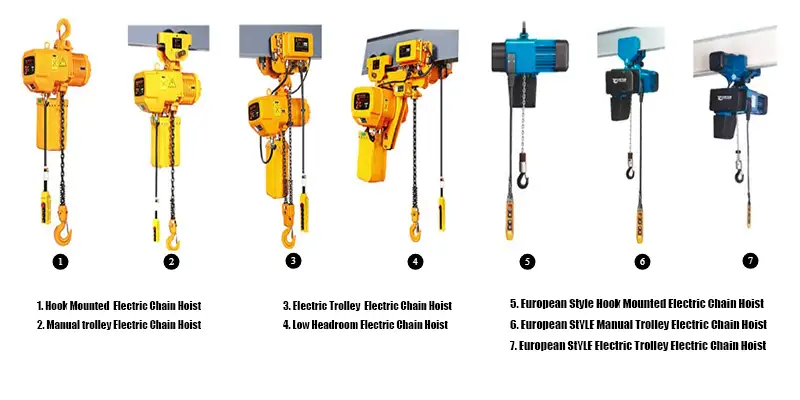
Types of Electric chain hoist for sale , the economical electric chain hoists and European style electric chain hoists
Where Is a Chain Hoist Used?
This hoist is ideal for light to medium-duty lifting, commonly found in:
- Workshops – Used to lift machine parts, molds, and tools for repair and maintenance work.
- Warehouses – Helps with stacking, loading, and unloading goods efficiently.
- Small Manufacturing Plants – Supports production lines by lifting raw materials or finished products.
- Assembly Lines – Assists in positioning heavy components during product assembly.
Advantages of a 3 Ton Electric Chain Hoist:
- Compact and lightweight – Easy to install and doesn't take up much space.
- Lower cost – More affordable than wire rope hoists, both in initial price and maintenance.
- Durable for moderate use – Can handle frequent but not continuous heavy lifting.
- Easier maintenance – Chains are simple to inspect and replace compared to wire ropes.
However, chain hoists have limitations. They generally lift at slower speeds compared to wire rope hoists and are better suited for shorter lifting heights rather than long vertical movements.
What Is a 3 Ton Wire Rope Hoist?
A 3-ton wire rope hoist works differently. Instead of a chain, it uses a steel wire rope wound around a drum to lift and lower loads. This design allows it to move loads more quickly and smoothly, making it a great choice for heavy-duty and high-frequency lifting operations.
Key Components and How They Work:
- Wire Rope – A flexible steel cable that supports the load. It wraps around the drum as the hoist operates.
- Drum – A rotating cylinder that winds and unwinds the wire rope to lift or lower the load.
- Motor – Provides the necessary power for lifting, often designed for continuous operation.
- Gearbox – Ensures controlled movement and adjusts the speed of lifting.
- Hook – Attaches securely to the load and often includes a safety latch.
- Control System – Like chain hoists, it comes with pendant or remote control for precise handling.
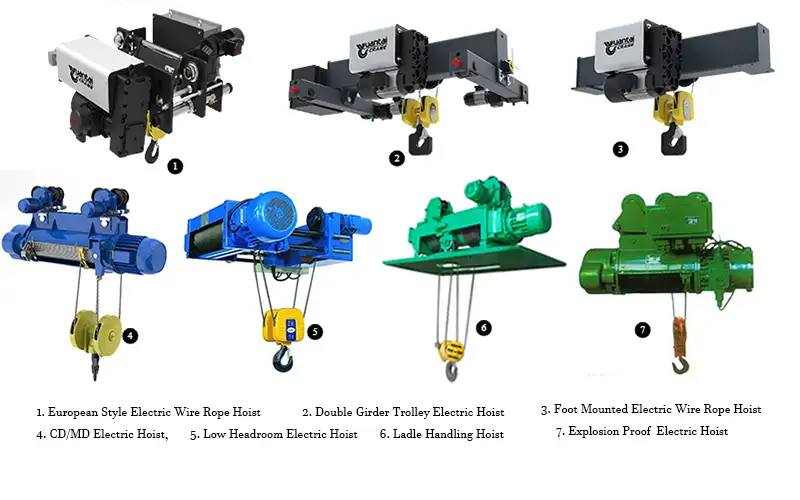
Types of electric wire rope hoist for sale , European style wire rope electric hoists and Economical cd/md wire rope electric hoists
Where Is a Wire Rope Hoist Used?
Wire rope hoists are built for high-speed, long-lift, and high-frequency operations, commonly used in:
- Large Factories – Moves heavy equipment or materials across production lines.
- Construction Sites – Lifts building materials such as steel beams, concrete blocks, and machinery.
- Heavy-Duty Industries – Used in steel mills, shipyards, and power plants for frequent lifting of massive loads.
- Cranes and Overhead Systems – Often installed on bridge cranes for fast and efficient load handling.
Advantages of a 3 Ton Wire Rope Hoist:
- Faster lifting speeds – Moves loads more efficiently over greater distances.
- Handles continuous heavy lifting – Designed for demanding industrial applications.
- More precise load positioning – Suitable for situations requiring fine control.
- Less chain swing – Wire ropes provide smoother and more stable movement than chains.
On the downside, wire rope hoists are more expensive than chain hoists, both in initial cost and maintenance. They require more space due to their larger size and have a more complex maintenance process because wire ropes wear out differently than chains.
Which One Should You Choose?
- If you need a compact, affordable, and easy-to-maintain hoist for occasional lifting in workshops, warehouses, or light-duty manufacturing → Go with a chain hoist.
- If you require high-speed, high-frequency, or long-distance lifting for heavy-duty operations like construction, large-scale manufacturing, or industrial use → A wire rope hoist is the better choice.
Each type has its strengths, and the best option depends on your lifting environment, load handling frequency, and budget.
Key Differences Between a 3 Ton Electric Chain Hoist and Wire Rope Hoist
When choosing the right lifting equipment for your needs, it's important to understand the key differences between a 3 ton electric chain hoist and a wire rope hoist. Both hoists are designed to lift 3 tons, but they perform differently based on mechanism, speed, durability, and maintenance needs. Let's break down the main differences to help you decide which one is the best fit for your application.
Lifting Mechanism
- 3 Ton Electric Chain Hoist: A chain hoist uses a steel chain that moves over a sprocket to lift and lower loads. This design is compact, making it ideal for low-headroom spaces.
- Wire Rope Hoist: A wire rope hoist uses a steel wire rope that winds around a drum. The wire rope system allows for smoother lifting over greater distances.
What This Means:
- A chain hoist is more suitable for compact spaces where you need precise and controlled lifting in short vertical distances.
- A wire rope hoist is better for longer lifting distances and provides smoother movement over time, making it ideal for larger spaces.
Lifting Speed
- 3 Ton Electric Chain Hoist: Typically, chain hoists have a slower lifting speed, around 2-8 meters per minute, allowing for more controlled lifting of loads.
- Wire Rope Hoist: Wire rope hoists are generally faster, with lifting speeds ranging from 8-20 meters per minute, making them ideal for high-volume, fast-paced environments.
What This Means:
- If you need precision lifting for small to medium loads, especially in workshops or small warehouses, a chain hoist will do the job well.
- If your job involves repetitive heavy lifting or high-speed operations, like in a factory or construction site, a wire rope hoist will be more efficient.
Durability and Load Handling
- 3 Ton Electric Chain Hoist: Chain hoists are durable but better suited for moderate lifting loads and occasional use. The chain is strong, though it's more prone to wear over time with heavy or continuous use.
- Wire Rope Hoist: Wire rope hoists are built for heavy-duty lifting and can handle high-frequency lifting with greater durability. They are designed for continuous operation and are ideal for heavy loads over long periods.
What This Means:
- A chain hoist is a great choice for light to medium-duty tasks where lifting is not frequent and the load is not extremely heavy.
- A wire rope hoist is better suited for high-volume operations that require constant lifting and handling of heavier loads without compromising on performance.
Maintenance and Lifespan
- 3 Ton Electric Chain Hoist: Chain hoists are easier to maintain. The chain is simple to replace and costs less to repair. Routine maintenance mainly involves lubrication to ensure smooth operation.
- Wire Rope Hoist: Wire rope hoists require more maintenance. The wire rope needs to be inspected regularly for wear, fraying, or damage. The drum system also requires more attention due to the higher frequency of use.
What This Means:
- If you want low-maintenance equipment and are working in a less demanding environment, a chain hoist is ideal.
- If you need a high-performance hoist for demanding, heavy-duty tasks, be prepared for the additional maintenance required for a wire rope hoist.
Space and Installation Requirements
- 3 Ton Electric Chain Hoist: Chain hoists are compact and work well in low-headroom spaces, which makes them easier to install in places with limited vertical space.
- Wire Rope Hoist: Wire rope hoists require more installation space because of the larger drum system and wire rope mechanism.
What This Means:
- If you have a small or confined workspace, like in a workshop or small warehouse, a chain hoist will fit more easily and require less space.
- If you're operating in a large industrial space with plenty of clearance, a wire rope hoist will handle longer lifts and greater loads without space constraints.
Cost and Budget Considerations
- 3 Ton Electric Chain Hoist: Chain hoists are generally more affordable both in terms of the initial purchase price and maintenance costs.
- Wire Rope Hoist: Wire rope hoists tend to be more expensive to buy and maintain due to their greater lifting capacity and durability.
What This Means:
- If you are working with a tight budget or need a cost-effective solution for lighter lifting needs, a chain hoist is the better choice.
- If you are looking for a high-performing hoist that can handle heavy-duty lifting and high-frequency use, investing in a wire rope hoist will be worth it for the long-term performance.
Final Verdict: Which One Should You Choose?
Choose a 3 Ton Electric Chain Hoist if:
- You need a compact, affordable, and low-maintenance hoist for light to moderate lifting tasks.
- Your workspace has limited clearance and you need a low-headroom solution.
- You are working with a tight budget and require occasional lifting of moderate loads.
Choose a 3 Ton Wire Rope Hoist if:
- You need a high-speed, high-frequency hoist for heavy-duty, continuous lifting.
- Your workspace is large and has sufficient clearance for installation.
- You are prepared to invest in higher upfront costs and maintenance for **long-term, high-performance use.
Ultimately, the right hoist depends on your specific lifting needs, available space, and budget. Whether you choose a 3 ton electric chain hoist or a wire rope hoist, understanding these key differences will help you make an informed decision that best suits your operations.
Here's a simplified version of the comparison table between a 3 Ton Electric Chain Hoist and a Wire Rope Hoist:
| Feature | 3 Ton Electric Chain Hoist | Wire Rope Hoist |
|---|---|---|
| How It Lifts | Uses a steel chain to lift loads. Good for tight spaces. | Uses a wire rope wound around a drum for smooth lifting. Best for larger spaces. |
| Lifting Speed | Slower, around 2-8 meters per minute. Great for controlled lifting. | Faster, about 8-20 meters per minute. Best for fast lifting. |
| Durability | Good for moderate loads. Works for occasional use. | Built for heavy-duty lifting and constant use. |
| Maintenance | Easy to maintain. Simple chain replacement and lubrication. | Requires more upkeep. Wire rope and drum need regular checks. |
| Space Needed | Compact design, fits well in small spaces. | Needs more space due to the larger drum and rope. |
| Cost | Affordable and cheaper to maintain. | More expensive with higher maintenance costs. |
| Best For | Light to moderate lifting in small workshops or warehouses. | Heavy lifting in factories or construction sites. |
Pros and Cons of Each Hoist Type
Pros of a 3 Ton Electric Chain Hoist
- Compact and Lightweight: The 3-ton electric chain hoist is perfect for tight spaces and low headroom environments. Its compact design makes it easy to install and maneuver, especially in smaller workshops and warehouses.
- Lower Cost and Easy Maintenance: One of the biggest advantages of a chain hoist is its affordability. It's generally cheaper to purchase and maintain compared to other hoist types. Routine maintenance is simple, usually requiring just lubrication and occasional chain replacements.
- Ideal for Limited Space Applications: The chain hoist's design allows it to work in places where space is at a premium. If your workspace is tight or has limited vertical clearance, a chain hoist is often the better choice.
- Reliable for Light-to-Medium Loads: Chain hoists are well-suited for light-to-medium lifting tasks. They perform reliably in environments where the load is not too heavy, and the lifting frequency is moderate.
Cons of a 3 Ton Electric Chain Hoist
- Slower Lifting Speeds: Compared to wire rope hoists, chain hoists generally have slower lifting speeds, usually around 2-8 meters per minute. This can be a disadvantage in environments where fast lifting is required.
- Not Ideal for Continuous Heavy-Duty Operations: While reliable for occasional use, chain hoists aren't built for heavy-duty, continuous lifting. They are better suited for light-to-medium tasks rather than high-frequency, heavy-duty operations.
Pros of a Wire Rope Hoist
- Faster Lifting Speeds: Wire rope hoists are generally faster than chain hoists, with lifting speeds ranging from 8-20 meters per minute. This makes them ideal for high-volume operations where speed is important.
- Handles Heavier Loads: Wire rope hoists are designed to handle heavy lifting and continuous use. They are built to withstand high-frequency, heavy-duty tasks, making them ideal for industries like construction and manufacturing.
- Smoother Lifting: The wire rope system provides smoother and more stable lifting, especially over longer distances. This can be beneficial when handling sensitive materials or when precise control over the load is required.
- Durable: Wire rope hoists are made to last, even in demanding environments. They are highly durable and can operate for long periods without compromising performance.
Cons of a Wire Rope Hoist
- Larger Size: Wire rope hoists are generally larger than chain hoists, which means they require more installation space. This can be a drawback in areas with limited clearance or tight spaces.
- Higher Cost and Maintenance: Upfront costs for wire rope hoists tend to be higher, and they also require more maintenance. The wire rope needs regular inspection, and the drum system requires attention to ensure smooth operation.
- Requires More Space: Due to the larger drum and wire rope system, wire rope hoists need more clearance during installation. They're better suited for larger industrial spaces where there is plenty of room for installation.
By weighing the pros and cons of both hoists, you can determine which option best suits your lifting needs and operational requirements. Whether you need a compact and cost-effective solution or a fast, heavy-duty lifting system, understanding these details will guide your decision.
Which One Is Best for Your Needs?
Choosing between a 3 Ton Electric Chain Hoist and a Wire Rope Hoist depends on your specific needs and the conditions of your work environment. Here's a guide to help you decide:
Choose a 3 Ton Electric Chain Hoist If:
- Cost-Effectiveness: You need a budget-friendly hoist. The chain hoist has lower upfront costs and simple maintenance, making it an economical option.
- Limited Space: Your workspace has low headroom or tight clearance. Its compact size fits well in smaller environments or places with space restrictions.
- Light-to-Medium Loads: You're handling light-to-medium loads that don't require constant lifting. It's ideal for environments where lifting is infrequent or the load is not too heavy.
- Low Maintenance: You want something that is easy to maintain. Chain hoists require minimal maintenance, usually just lubrication and the occasional chain replacement.
Choose a Wire Rope Hoist If:
- High-Speed, Heavy-Duty Lifting: You need a hoist that handles faster lifting speeds and high-frequency operations. Wire rope hoists are perfect for heavy-duty lifting with continuous use.
- Larger Workspaces: Your workspace is more spacious and has enough clearance for installation. The wire rope hoist requires more room due to the larger drum and rope system.
- Heavy Loads and Precision: You're lifting heavier loads or sensitive materials. Wire rope provides smoother, more controlled lifting, making it ideal for jobs requiring precision over longer distances.
- Durability and High Frequency: Your operations involve frequent lifting over extended periods. Wire rope hoists are built for heavy-duty, high-frequency lifting, ensuring long-lasting performance.
Consider the Following Factors:
- Budget: If you're looking for an affordable option, the 3-ton electric chain hoist offers great value for light-to-medium lifting tasks.
- Lifting Speed: If speed and efficiency are important for your operations, a wire rope hoist is the better choice, with its faster lifting capabilities.
- Work Environment: Evaluate your available space. If you're working in a tight or low-clearance area, the chain hoist is the better fit. For larger areas with enough headroom, a wire rope hoist works best.
- Load Frequency: If you need to lift heavy loads or perform frequent lifting, the wire rope hoist is designed for heavy-duty operations. If the lifting is occasional or light, the 3-ton electric chain hoist is sufficient.
By carefully considering these factors, you can choose the hoist that best fits your needs—whether it's the cost-effective, compact chain hoist or the fast, heavy-duty wire rope hoist.
Main Projects
Related Products
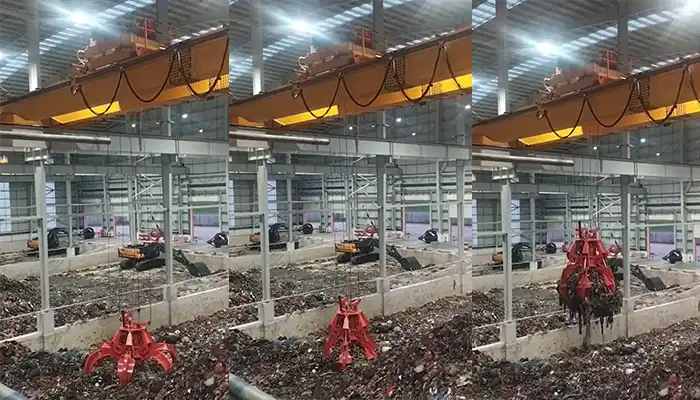
Supplied three grab bucket crane kits to Indonesia, enhancing garbage handling efficiency with high load capacity and reliable performance.
Free consultation to Confirm Parameters & Specifications and Get
Latest Crane Price & Crane Rate.
- Types of overhead cranes : _______?
- Optional: Overhead travelling crane, goliath gantry crane,Slewing jib crane, Single girder or double girder crane,small portable crane or kbk crane, etc.
- Capacity of overhead crane: _______?
- Optional: 0.25ton, 0.5 ton, 1 ton, 2 ton, 3ton, 5 ton, 10 ton,15ton, 20ton, 25 ton, 30ton,35ton, up to 550ton, etc.
- Crane span & lifting height : _______?
- Crane travelling length : _____?
- Control of overhead crane:_______?
- Optional: pendant/ remote/cabin control
- Voltage supply of overhead crane:_____?
- Eg,: 380V50/60HZ,3Phase or others,etc.
- Application/usage of crane:_______?
- Eg,: Steel mill, ,injection mold, cement,stone, concrete,granite, general manufacturing, etc.
Just leave a message via the contact form and our hoist and crane engineer will contact you with in 24working hours.
Get In Touch
